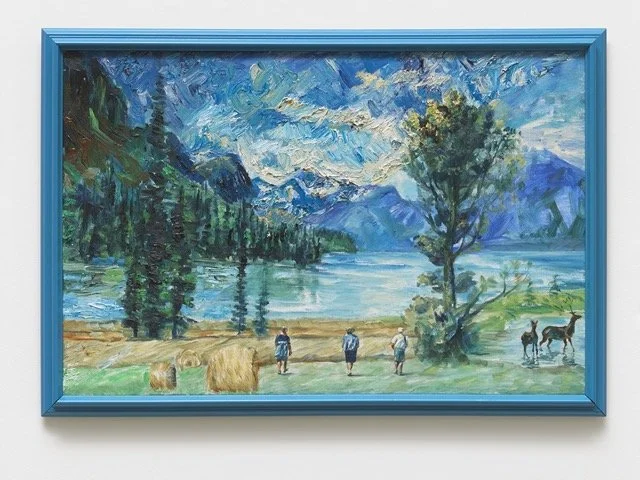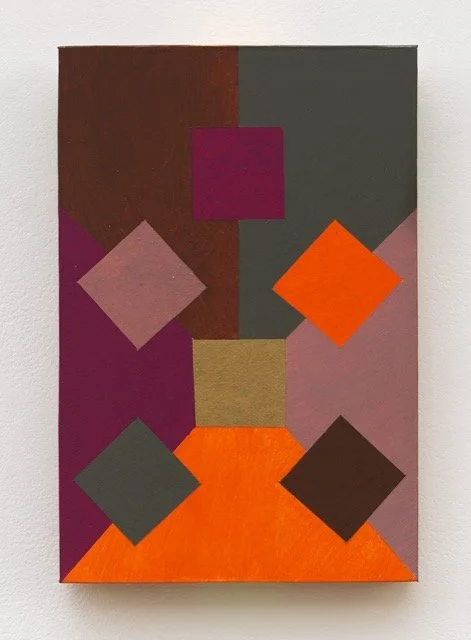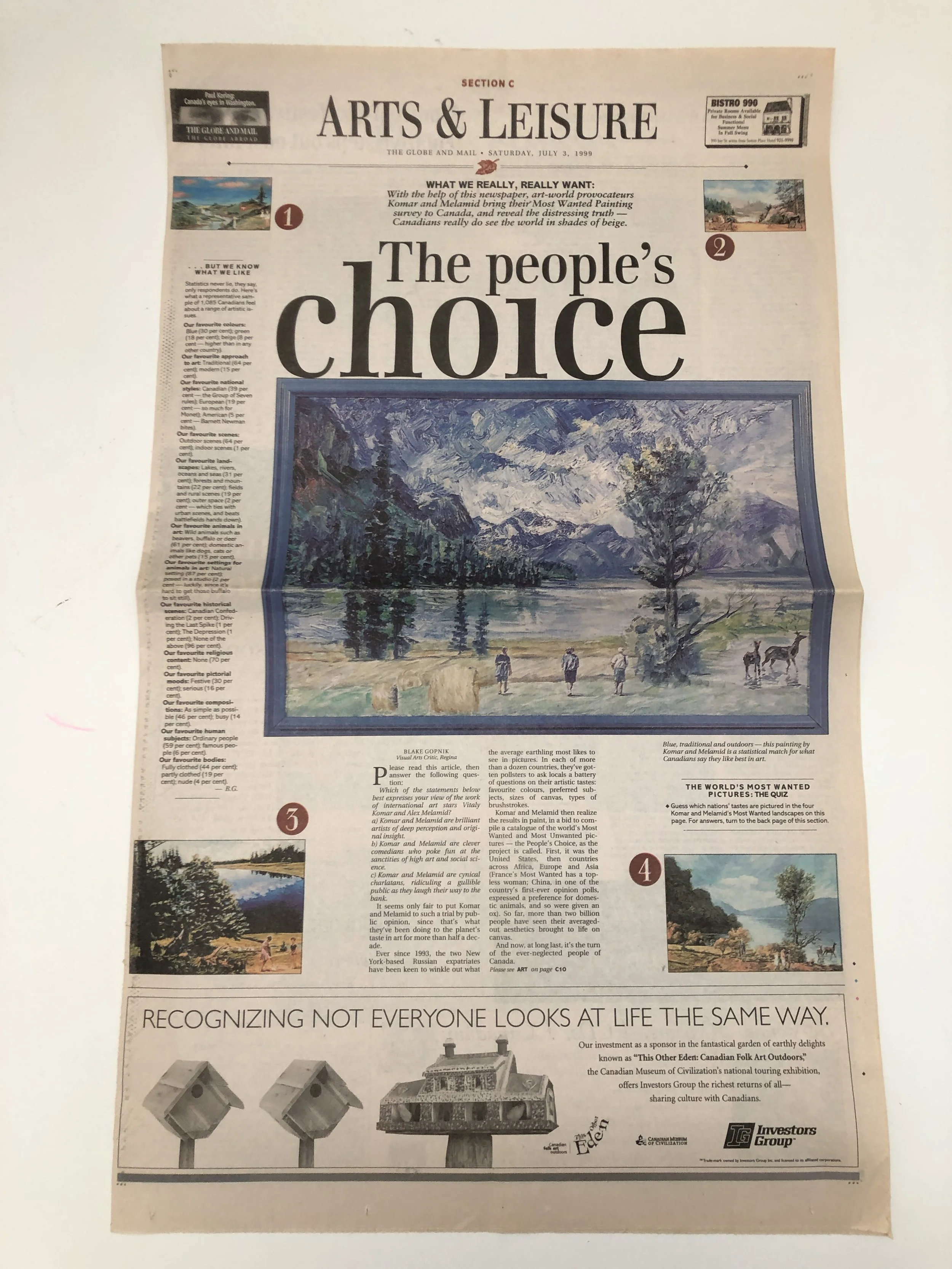
Komar and Melamid: Canada’s Most Wanted and Most Unwanted Paintings
Vitaly Komar and Alex Melamid were born in Moscow, Komar on September 11, 1943 and Melamid on July 14, 1945. Both artists attended the Moscow Art School from 1958 to 1960, and the Stroganov Institute of Art and Design, Moscow, from 1962 to 1967. Their collaborative work started in 1965, and in 1967, they initiated the SOTS Art movement (the Soviet version of western pop art). Their first international exhibition was at Ronald Feldman Fine Arts, New York, in 1976. Since then, they have had numerous public commissions and exhibitions throughout the world. In 1978, the artists emigrated to the United States.
Komar and Melamid provocatively examine the art and ideas that emerge under the totalitarian state as well as the democratic state. Their project, entitled The People's Choice, began in 1993 when they hired an American polling firm to find out what Americans wanted in art. 1001 respondents were asked a 24 minute / 103 question poll on their criteria for acquiring objects I products, the type of art they owned, their favourite subjects, colours and compositional elements in a painting, their impression of selected artists and their socio-economic backgrounds. From this data America's Most Wanted and America's Most Unwanted paintings were produced. The People's Choice project was subsequently expanded to produce the most wanted and the most unwanted paintings of France, Denmark, China, Finland, Germany, Holland, Iceland, Italy, Kenya, Portugal, Ukraine, Turkey and Russia.
Canada's Most Wanted and Canada's Most Unwanted paintings were commissioned by the Vancouver Art Gallery and Dunlop Art Gallery, Regina Public Library in the spring of 1999. The scale, composition and subject matter of the paintings were determined by interpreting data gathered in a national poll conducted by the Angus Reid Group.
Canada's Most Wanted painting is an Arcadian landscape of blues (30%) and greens (18%) and beige (8%). A pair of deer canter about in a pale blue pond, and to their left a trio of pedestrians sporting various shades of Canada’s favorite (blue), stroll across a freshly harvested field of hay. They stride toward an expansive lake that recedes into the craggy snowcapped mountains.
Canada's Most Unwanted painting is a pocketbook-sized panel painted in mauve, maroon, brown, orange and gold. The composition is abstract with sharp, angular shapes arranged in an asymmetrical geometric pattern. Together they represent the statistically accurate, but aesthetically improbable, tastes of the Canadian public at the turn of this century.
Prior to the production of the artwork on May 29, 1999, the artists held a town hall meeting in Regina to ask Canadians what they wanted to see in a painting. Alex Melamid subsequently participated in a summer residency at The Banff Centre to conduct further Canadian research.
The travelling exhibition, which first opened at the Dunlop Art Gallery in Regina in July 1999, was organized collaboratively by the Dunlop Art Gallery and the Vancouver Art Gallery. Anthony Kiendl (DAG) and Bruce Grenville (VAG) developed the show, with each gallery's staff. Directors Alf Bogusky (then a the VAG) and Helen Marzolf (DAG) fostered the critical environments required to make this project work. The Banff Centre also supported the project.
Judith Mastai, then head of public programs at the Art Gallery of Ontario, played a critical role in the conception of the project and the exhibition's final content and look. A process of community involvement was extended into the gallery exhibition. Recognizing the value of audience participation in making this project a success, Mastai developed a strategy to incorporate each venue's permanent collection into the exhibition. Not only did this allow regional particularities and histories to play themselves out in the context of this discourse, but it allowed the patrons to participate by "voting" on the works in the gallery's collection. Mastai's program encouraged patrons to take an active role in assessing works of art.
The Globe and Mail newspaper not only provided a financial contribution to the project, but disseminated the results to a national audience—fittingly on Canada Day, July 1, 1999—with an article by art critic Blake Gopnik. The Globe also distributed the exhibition publication (a tabloid broadsheet) through each copy of the newspaper in Saskatchewan on July 24, 1999, to coincide with the exhibition opening. The entire poll is reproduced in the exhibition publication.
The exhibition toured nationally to the Dunlop Art Gallery (1999); the Art Gallery of Windsor (2000); The Edmonton Art Gallery (2000); the Mendel Art Gallery (2000); the Vancouver Art Gallery (2001).

Komar and Melamid "Canada's Most Wanted Painting," 1999. Oil on canvas/painted frame 68.0 x 98.5 x 4.0 cm.

Komar and Melamid "Canada's Most Unwanted Painting," 1999. oil on paperboard 23.0 x 15.3 x 2.0 cm.

Exhibition publication, distributed as insert in the Globe and Mail newspaper. Catherine Bradbury Design.

Globe and Mail coverage and painting reveal, Canada Day, 1999 (front of Arts section).

Globe and Mail coverage and painting reveal, Canada Day, 1999 (back of arts section).

Komar and Melamid Town Hall Meeting on Canadian likes and dislikes in painting, May 29, 1999. Unitarian Centre, Regina, Canada.

The Angus Reid poll of Canadian likes and dislikes in art.

Komar and Melamid Town Hall invitation.

Komar and Melamid Town Hall invitation (verso).